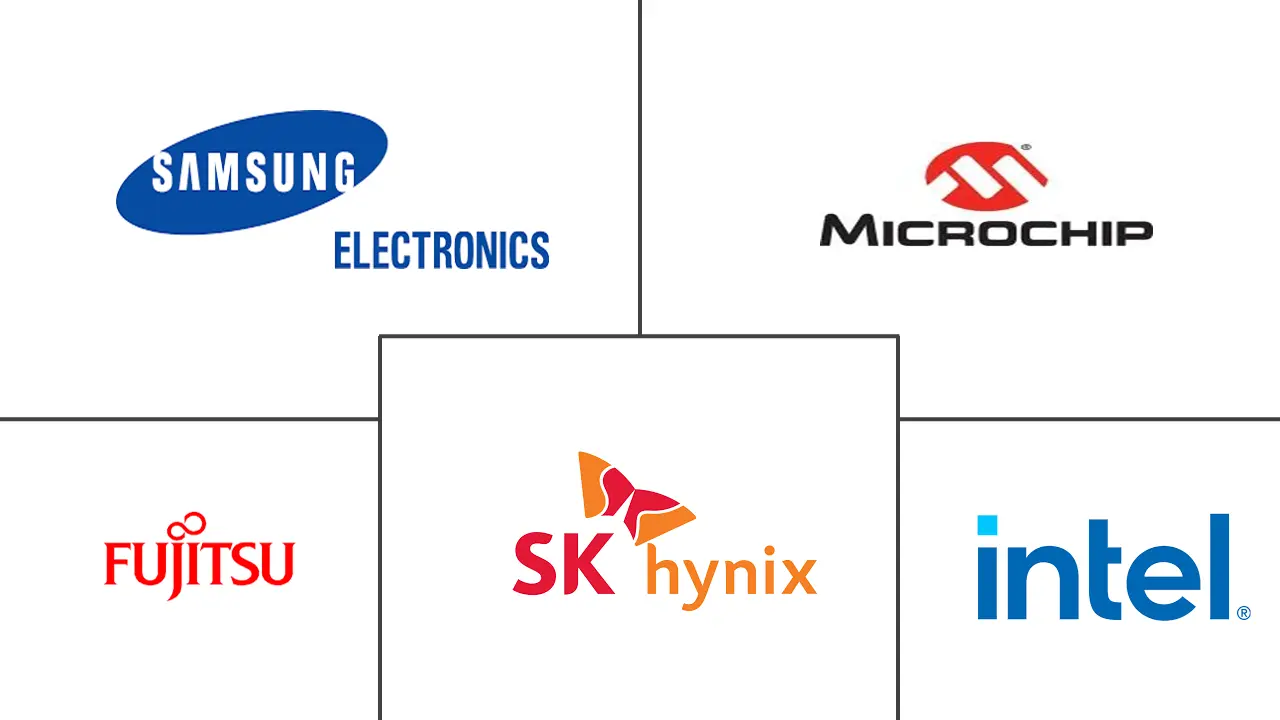Global Standalone Memory Market Size and Share
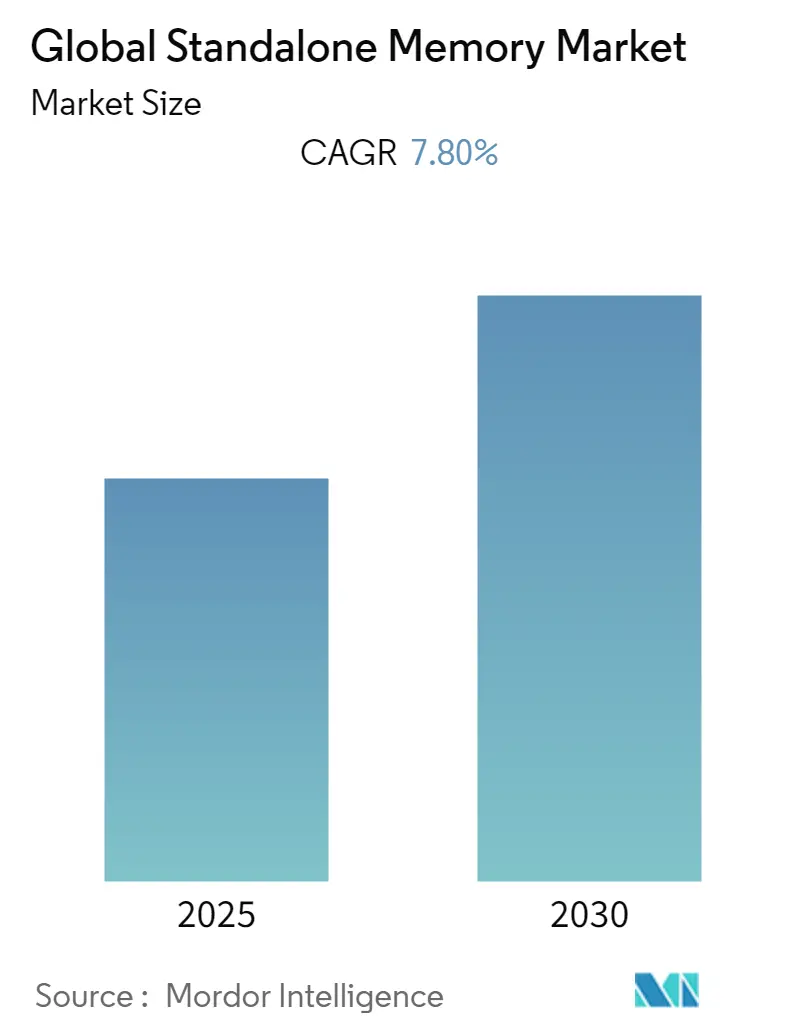
Global Standalone Memory Market Analysis by Mordor Intelligence
The Global Standalone Memory Market is expected to register a CAGR of 7.8% during the forecast period.
- The increasing use of internet of things devices and adoption of sensor technology such as wearable and AI-enabled devices have boosted demand for fast data transfers and high storage density, providing a tremendous chance or possibility for the growth of the standalone memory market globally. According to Applied Materials, the exponential volumes of data generated via IoT and edge devices and by internet users act as a catalyst to drive the commercialization of such memory. Artificial intelligence and data analytics applications are largely driving the demand for this data.
- The exponential growth of data generated shows no indications of abating. During the COVID-19 pandemic, the work-from-home trend resulted in a massive data increase through applications such as video conferencing. New applications, such as AI and AR/VR, are projected to become commonplace in the forecast period, resulting in a further data boom. As a result of the increase in data, memory technology is being pushed to new standards. To fulfill these demands, DRAM and NAND have scaled up.
- Additional memory technologies, on the other side, must be developed to keep up with the data growth. In September 2021, SK Hynix, a South Korean firm, stated that three new technologies, STT-MRAM, Ferroelectric Memory, and ReRAM, could play a role in processing larger quantities of data.
- The rising need to handle the proliferation of data due to the adoption of IoT further drives the market. The adoption of IoT devices is taking place at a rapid pace. Various government initiatives worldwide, like smart cities, are supporting the deployment of these devices at a much faster pace.
Global Standalone Memory Market Trends and Insights
Automotive Expected to Witness Significant Market Share
- The applications of standalone memory are spanning in the automotive sector due to the rise of self-driving cars and ADAS integration, among others. The advancement in the automotive sector has driven the adoption of high-performance memory, which supports the market's growth.
- The core of autonomous vehicles will be advanced driver assistance systems (ADAS) with multiple sensors (AVs). Vehicles will increasingly be designed to collect, analyze, and store data locally and selectively upload data at the optimal period. This will necessitate the vehicle's installation of data storage and computing equipment. The core of autonomous vehicles will be advanced driver assistance systems (ADAS) with multiple sensors (AVs). Vehicles will increasingly be designed to collect, analyze, and store data locally and selectively upload data at the optimal period.
- The significant growth in the automotive sector alongside the integration and demand for memory devices is analyzed to boost the market growth rate during the forecast period. For instance, In July 2021, Fujitsu began mass production of 4Mbit FRAM that can operate at 125°C and is automotive grade. This FRAM product meets the AEC-Q100 Grade 1 qualification criteria for "automotive grade" components, suitable for industrial robots and automotive applications such as advanced driver-assistance systems (ADAS) that demand high-reliability electronic components.
- Also, In December 2021, Samsung began mass production of comprehensive automotive memory solutions for next-generation autonomous electric vehicles. Samsung Electronics has released a broad range of advanced automotive memory solutions for next-generation self-driving cars. For high-performance infotainment systems, the new lineup includes a 256-gigabyte (GB) PCIe Gen3 NVMe ball grid array (BGA) SSD, 2GB GDDR6 DRAM, 2GB DDR4 DRAM, 2GB GDDR6 DRAM, and 128GB Universal Flash Storage (UFS) for autonomous driving systems.
- The market focuses on automotive DRAMs, and various innovations are witnessed in the segment. For instance, in February 2021, Micron Technology, Inc. announced the launch of the automotive low-power DDR5 DRAM (LPDDR5) memory that has been hardware-tested to achieve the most stringent Automotive Safety Integrity Level (ASIL), ASIL D. Micron's new portfolio of memory and storage products based on the International Organization for Standardization (ISO) 26262 standard is aimed at functional vehicle safety.
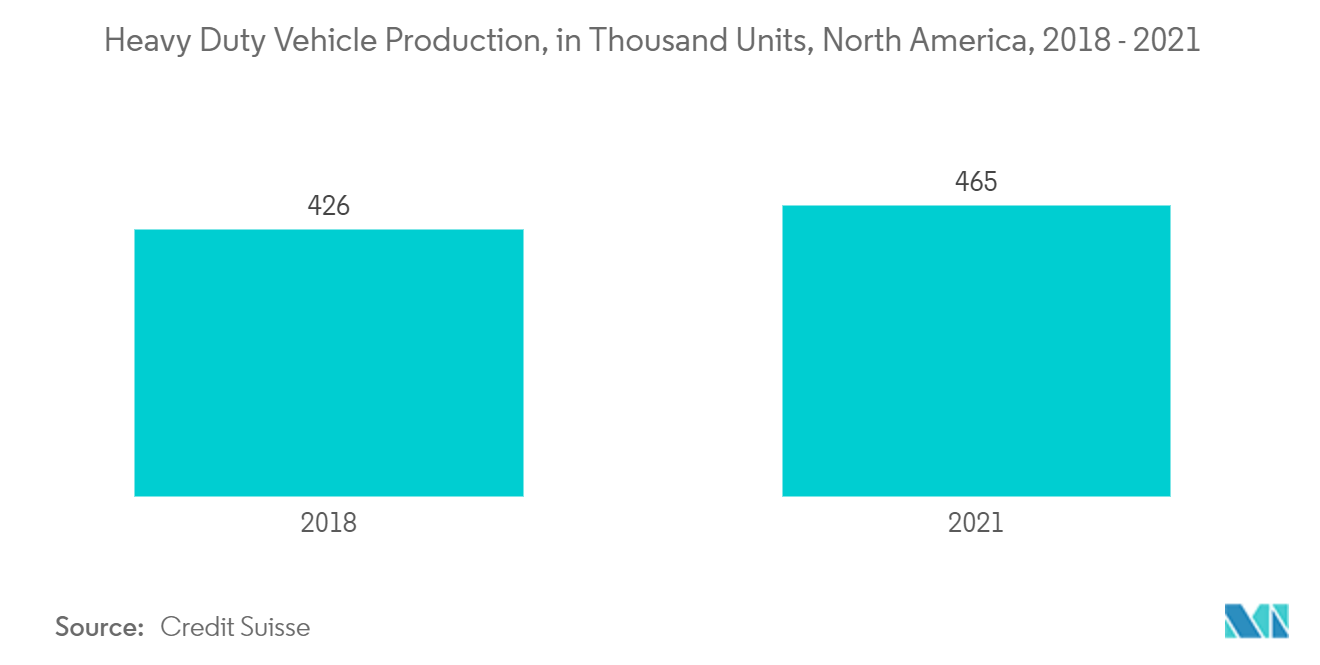
Asia Pacific Expected to Witness Significant Market Share
- The semiconductor manufacturing market in Asia Pacific is the most significant in the region, driving the consumer electronics market. The presence and demand from various manufacturing sectors such as consumer electronics, automotive, and so on in the countries such as China, India, Japan, and South Korea are analyzed to bolster the demand for standalone memory in the region.
- eMemory has made a long-term investment in China and partnered with foundry partners to implement various embedded non-volatile memory (eNVM) on multiple platforms, ranging from mature to advanced nodes, using one-time programmable (OTP) and multiple-times programmable (MTP) solutions. In Q3/2021, eMemory launched its initial ReRAM IP on UMC's 40nm ULP (ultra-low power) process, and it is currently researching a 22nm version.
- India Brand Equity Foundation (IBEF) stated that the country's electronics hardware production stood at USD 63.39 billion in 2021. Moreover, according to India Cellular & Electronics Association (ICEA), India has the potential to achieve a value of USD 100 billion in manufacturing of laptops and tablets by 2025. It is analyzed to boost the demand for memory devices, contributing to the market growth rate during the forecast period.
- According to Invest in India, a National Investment Promotion and Facilitation Agency, India's automotive industry is valued at more than USD100 billion, produces 8% of total exports, accounts for 2.3% of GDP, and is on pace to become the global third-largest by 2025. In December 2021, Hyundai announced an investment of USD 530.25 million in R&D in India to launch six EVs by 2028. In October 2021, Tata Motors stated that private equity firm TPG and Abu Dhabi's ADQ had agreed to spend USD 1 billion in its electric vehicle sector. These factors collectively contribute to the market growth rate during the forecast period.
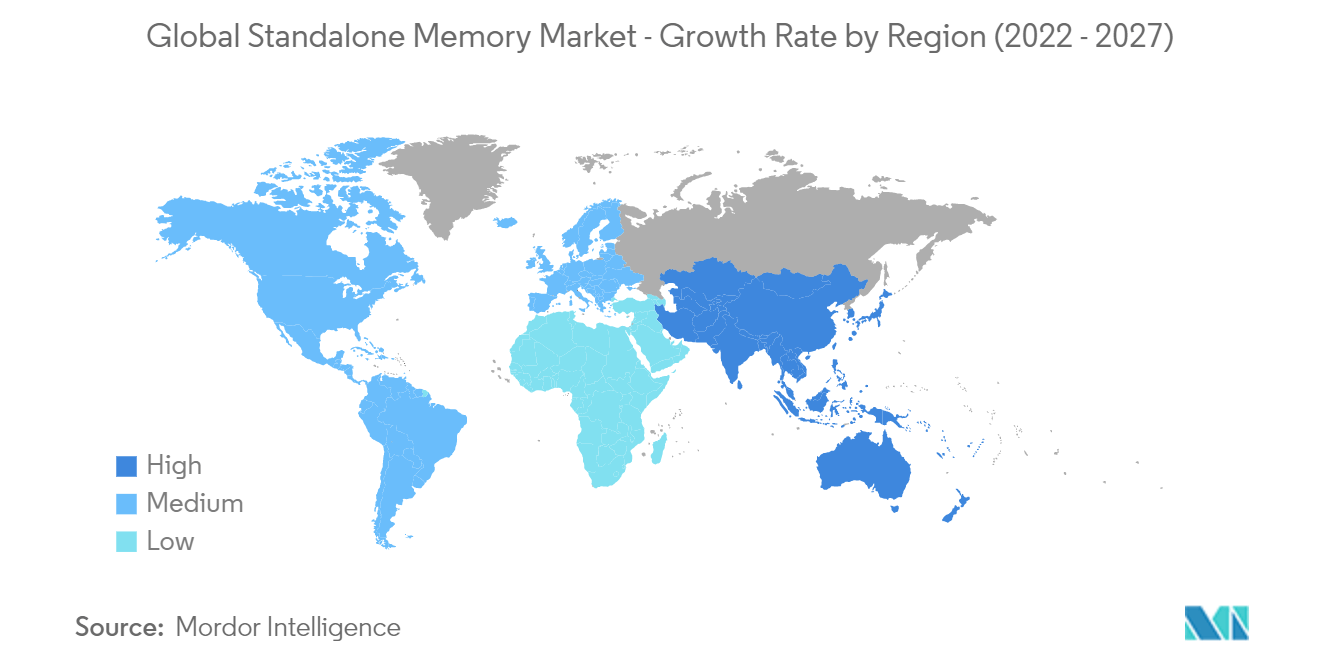
Competitive Landscape
The Global Standalone Memory Market is moderately competitive, with many regional and global players. Innovation drives the market in the product offerings, and each vendor invests in innovation. Key players include Samsung Electronics Co. Ltd, SK Hynix Inc., Microchip Technology Inc., Fujitsu Semiconductor Memory Solution, and Intel Corporation.
- May 2022 - SK Hynix, a prominent DRAM manufacturer, displayed at the Intel Vision conference, showcasing the latest memory solutions for server applications, including DDR5 DIMM and next-generation technologies like Processing in Memory (PiM) and Compute Express Link (CXL).
- March 2021- Samsung Electronics has added the 512GB DDR5 module based on the High-K Metal Gate (HKMG) manufacturing technology to its DDR5 DRAM memory portfolio. The new DDR5 will be capable of organizing the most extreme computationally intensive, high-bandwidth workloads in supercomputing, artificial intelligence (AI), and machine learning (ML), as well as data analytics applications, with performance more than twice that of DDR4 at up to 7,200 megabits per second (Mbps).
Global Standalone Memory Industry Leaders
-
Samsung Electronics Co. Ltd
-
Microchip Technology Inc.
-
SK Hynix Inc.
-
Fujitsu Semiconductor Memory Solution (Fujitsu Group)
-
Intel Corporation
- *Disclaimer: Major Players sorted in no particular order
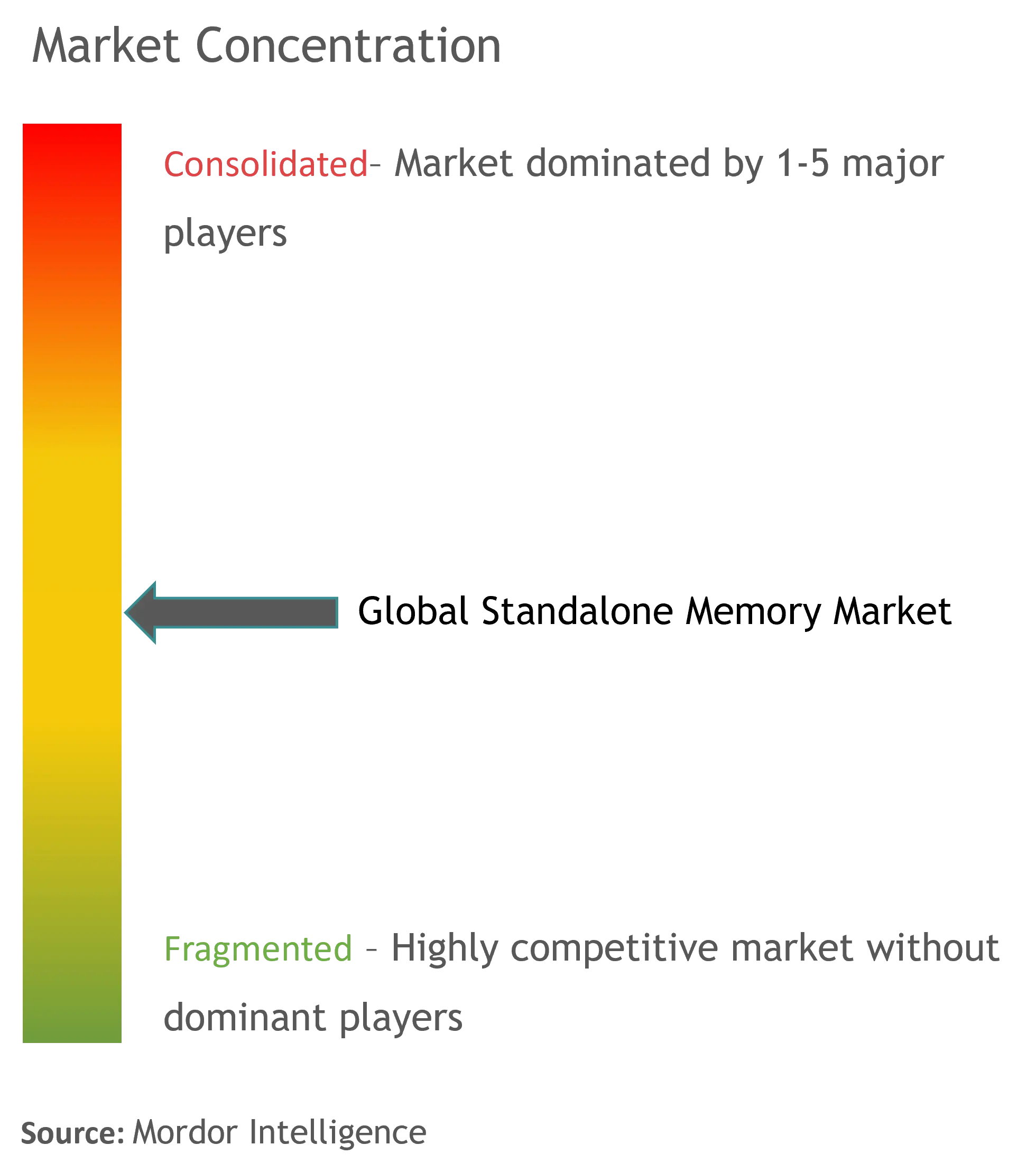
Recent Industry Developments
- January 2022- Fujitsu Semiconductor Memory Solution Limited launched an 8Mbit FRAM MB85RQ8MLX with Quad SPI interface, which is the highest density in Fujitsu's FRAM product family with SPI interface. This latest product achieves a rapid data transfer rate of 54MB per second at a maximum operating frequency of 108MHz in high-temperature conditions up to 105°C.
Global Standalone Memory Market Report Scope
Standalone memory includes dynamic random access memory (DRAM), ferroelectric RAM (FRAM), static RAM (SRAM), NAND, and NOR. The study covers standalone types across major end-users such as automotive, consumer electronics, and industrial. The study also covers demand across various regions and considers the impact of COVID-19 on the market.
| DRAM |
| NAND |
| NOR |
| (NV)SRAM /FRAM |
| Other Product Types |
| Automotive |
| Consumer Electronics |
| Enterprise |
| Other End-user Industries |
| North America |
| Europe |
| Asia Pacific |
| Rest of the World |
| By Product Type | DRAM |
| NAND | |
| NOR | |
| (NV)SRAM /FRAM | |
| Other Product Types | |
| By End-User Industry | Automotive |
| Consumer Electronics | |
| Enterprise | |
| Other End-user Industries | |
| By Geography | North America |
| Europe | |
| Asia Pacific | |
| Rest of the World |
Key Questions Answered in the Report
What is the current Global Standalone Memory Market size?
The Global Standalone Memory Market is projected to register a CAGR of 7.8% during the forecast period (2025-2030)
Who are the key players in Global Standalone Memory Market?
Samsung Electronics Co. Ltd, Microchip Technology Inc., SK Hynix Inc., Fujitsu Semiconductor Memory Solution (Fujitsu Group) and Intel Corporation are the major companies operating in the Global Standalone Memory Market.
Which is the fastest growing region in Global Standalone Memory Market?
Asia-Pacific is estimated to grow at the highest CAGR over the forecast period (2025-2030).
Which region has the biggest share in Global Standalone Memory Market?
In 2025, the North America accounts for the largest market share in Global Standalone Memory Market.
What years does this Global Standalone Memory Market cover?
The report covers the Global Standalone Memory Market historical market size for years: 2019, 2020, 2021, 2022, 2023 and 2024. The report also forecasts the Global Standalone Memory Market size for years: 2025, 2026, 2027, 2028, 2029 and 2030.
Page last updated on:
Global Standalone Memory Market Report
Statistics for the 2025 Global Standalone Memory market share, size and revenue growth rate, created by Mordor Intelligence™ Industry Reports. Global Standalone Memory analysis includes a market forecast outlook for 2025 to 2030 and historical overview. Get a sample of this industry analysis as a free report PDF download.
